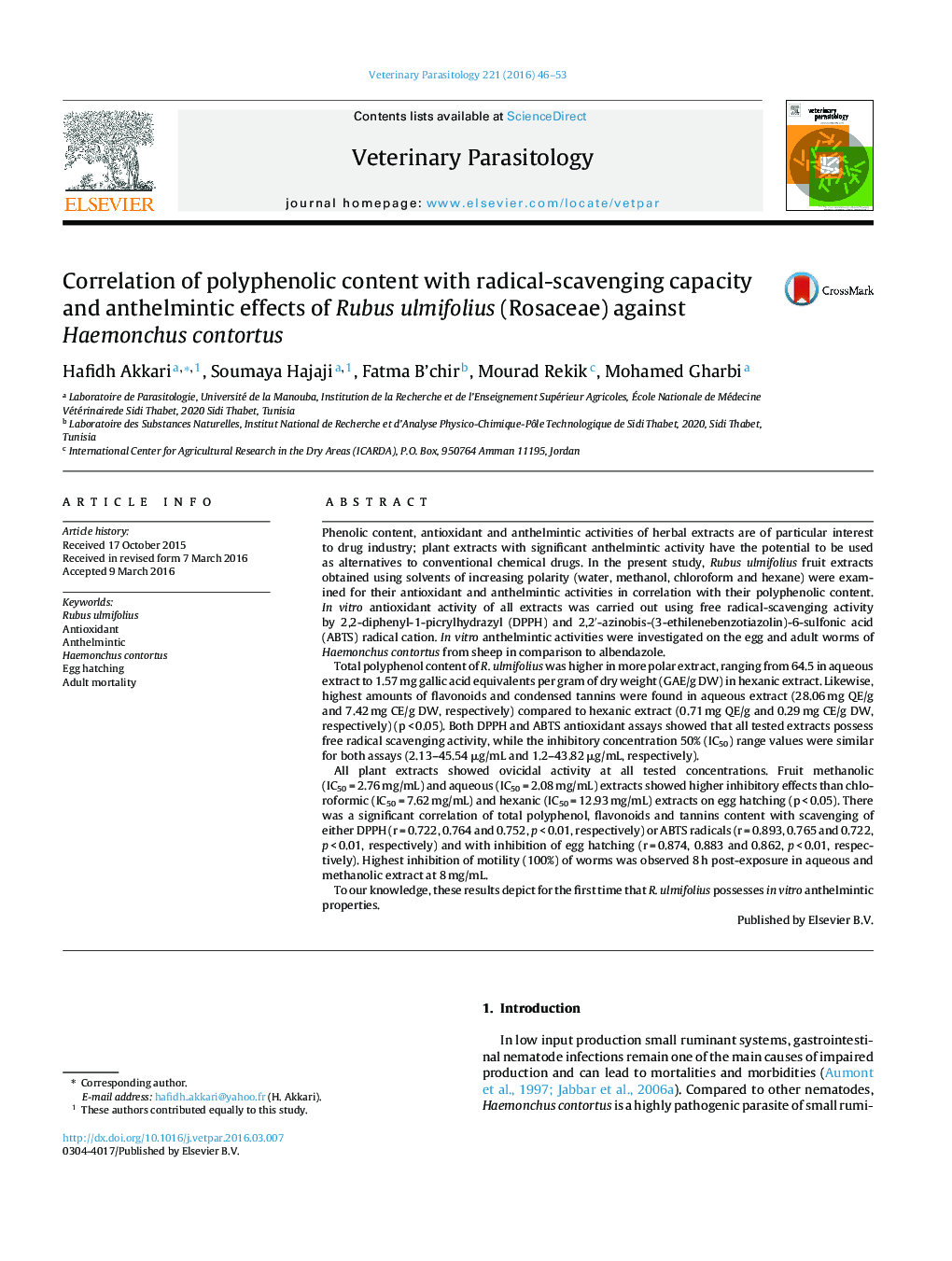| کد مقاله | کد نشریه | سال انتشار | مقاله انگلیسی | نسخه تمام متن |
|---|---|---|---|---|
| 5802184 | 1555655 | 2016 | 8 صفحه PDF | دانلود رایگان |

- Antioxidant and anthelmintic activities of R. ulmifolius fruits extracts were tested.
- Fruits extracts present a higher amount of total phenolics, flavonoids and tannins.
- Fruits extracts showed significant in vitro antioxidant and anthelmintic activities.
- High correlation exists between phenolic content and biological activities.
- Extracts can be used as natural antioxidant and anthelmintic in food/drug industries.
Phenolic content, antioxidant and anthelmintic activities of herbal extracts are of particular interest to drug industry; plant extracts with significant anthelmintic activity have the potential to be used as alternatives to conventional chemical drugs. In the present study, Rubus ulmifolius fruit extracts obtained using solvents of increasing polarity (water, methanol, chloroform and hexane) were examined for their antioxidant and anthelmintic activities in correlation with their polyphenolic content. In vitro antioxidant activity of all extracts was carried out using free radical-scavenging activity by 2,2-diphenyl-1-picrylhydrazyl (DPPH) and 2,2â²-azinobis-(3-ethilenebenzotiazolin)-6-sulfonic acid (ABTS) radical cation. In vitro anthelmintic activities were investigated on the egg and adult worms of Haemonchus contortus from sheep in comparison to albendazole.Total polyphenol content of R. ulmifolius was higher in more polar extract, ranging from 64.5 in aqueous extract to 1.57 mg gallic acid equivalents per gram of dry weight (GAE/g DW) in hexanic extract. Likewise, highest amounts of flavonoids and condensed tannins were found in aqueous extract (28.06 mg QE/g and 7.42 mg CE/g DW, respectively) compared to hexanic extract (0.71 mg QE/g and 0.29 mg CE/g DW, respectively) (p < 0.05). Both DPPH and ABTS antioxidant assays showed that all tested extracts possess free radical scavenging activity, while the inhibitory concentration 50% (IC50) range values were similar for both assays (2.13-45.54 μg/mL and 1.2-43.82 μg/mL, respectively).All plant extracts showed ovicidal activity at all tested concentrations. Fruit methanolic (IC50 = 2.76 mg/mL) and aqueous (IC50 = 2.08 mg/mL) extracts showed higher inhibitory effects than chloroformic (IC50 = 7.62 mg/mL) and hexanic (IC50 = 12.93 mg/mL) extracts on egg hatching (p < 0.05). There was a significant correlation of total polyphenol, flavonoids and tannins content with scavenging of either DPPH (r = 0.722, 0.764 and 0.752, p < 0.01, respectively) or ABTS radicals (r = 0.893, 0.765 and 0.722, p < 0.01, respectively) and with inhibition of egg hatching (r = 0.874, 0.883 and 0.862, p < 0.01, respectively). Highest inhibition of motility (100%) of worms was observed 8 h post-exposure in aqueous and methanolic extract at 8 mg/mL.To our knowledge, these results depict for the first time that R. ulmifolius possesses in vitro anthelmintic properties.
Journal: Veterinary Parasitology - Volume 221, 15 May 2016, Pages 46-53